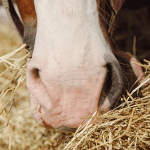Elbow Room: How Much Space Does a Horse Need at an Automated Feeder?

Automated feeding systems, such as time-controlled hay racks, have multiple benefits, which explains their growing popularity. However, sufficient space between horses is needed to minimize, and preferably prevent, aggressive behavior and stress responses, both indicators of poor welfare.
While manufacturers suggest an optimal animal-to-feeding-place ratio (AFR) for time-controlled hay racks, nothing definitive has been published. A study was therefore performed to determine appropriate AFRs that would allow horses stress-free intake without aggressive encounters with herdmates.*
To do this, 28 horses residing in a loose housing system had access to time-controlled hay racks with a total of 20 “openings” or feeding spots where horses could access hay. Horses were given access to hay from the feeders every 2 hours (except between midnight and 7 a.m.) for a total of 4.2 hours per day.
Horse behavior was observed and salivary cortisol levels were measured as indicators of stress during feeding. For behavior, video recordings were made of horses at the hay racks and aggressive behaviors were noted, including pinning ears, swinging head, threatening to bite or kick, biting and kicking, attacking, and displacing other horses from the feeder. Cortisol, the “stress hormone,” was measured in the horses’ saliva at baseline (50 and 30 minutes prior to feeding) and again 15 and 35 minutes after the hay feeders closed.
Four different animal-to-feeding-place ratios (AFRs) were evaluated in this study. The manufacturer recommended one horse per opening at the feeder (1:1), so that ratio was used, as was a ratio of 1:1.2 (20% more feeding spots than horses), 1:2 (twice as many feeding spots than horses), and 1:3 (three times as many feeding spots than horses). These ratios were obtained by removing the appropriate number of horses from the 28-horse herd.
Key findings of the study included:
- A linear decrease in aggressive behaviors associated with a low risk of injury (e.g., pinning ears, head swinging, bite and kick threats) with increased availability of feeding places;
- Aggressive behaviors with a high risk of injury (e.g., biting, kicking, attacking) occurred exclusively when horses were fed at the 1:1.2 and 1:2 ratios; and
- Salivary cortisol levels decreased with increasing AFR.
“These results show that fewer aggressive behaviors occurred with higher AFRs (i.e., more feeding spots per horse). The low salivary cortisol levels in the horses fed at an AFR of 1:3 confirm that horses appear more relaxed when they had three times as many feeding places as horses,” explained Kathleen Crandell, Ph.D., a nutritionist for Kentucky Equine Research.
Based on these findings, when an appropriate AFR is selected, automated feeding systems can be highly beneficial.
Automated feeding systems allow individual horses maintained in groups to have access to roughage while preventing obesity due to excessive energy (caloric) intake. While having access to the hay feeders for only 4.2 hours per day may seem to be inadequate “foraging” time, horses in this study also had ad libitum access to straw outside of the automated feeding system to satisfy their foraging needs.
But what about the easy keeper and ensuring a balanced diet when using automated systems?
“For horses that do not maintain weight on forage alone, they will still need to be offered supplemental feed to meet their caloric demands. Even if a horse is not getting supplemental feed, we recommend feeding some type of vitamin and mineral supplement to balance the nutrient shortcomings of an all-forage diet,” Crandell recommended.
*Baumgartner, M., M.H. Erhard, and M.H. Zeitler-Feicht. 2023. Which animal-to-feeding-place ratio at time-controlled hay racks is animal appropriate? Preliminary analysis of stress responses of horses. Frontiers in Veterinary Science 9:1005102.








